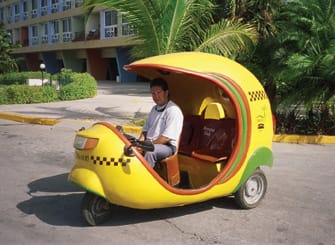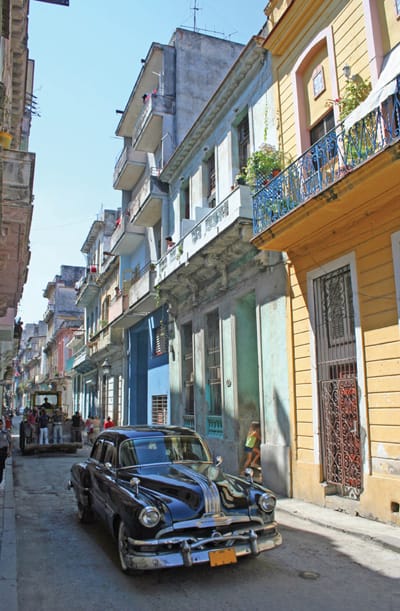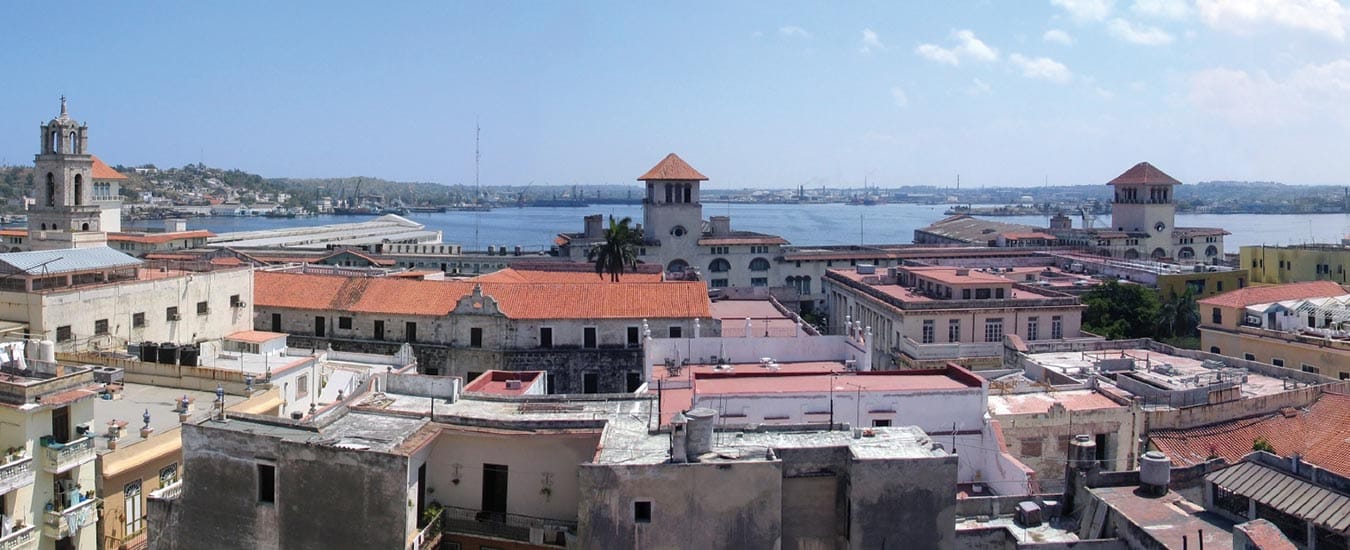The true beauty of Cuba lies in its people.
Cuba is an enigma: a socialist country with an eminently capitalist tourist industry. A population that has suffered much hard-ship, yet whose people have retained 100 per cent of their dignity and can still smile with purity and live with hope. Cuba's is an economy that manages against all odds to keep its head above water while offering its people high standards of free education and health care. It's an amazing place.
During the past 15 years, Cuba has become one of the Caribbean's prime travel destinations, attracting more than two million visitors annually (many of them Canadians) to hotels that can stand proudly beside some of the best the region has to offer. Varadero Beach, with its unparalleled 11.5 km stretch of uninterrupted seafront, is fast becoming the new Cancun.
Apart from Varadero with its 50 or more hotels, popular resort areas include Cayo Coco, Santa Lucía and Guardalavaca on the Atlantic coast; the dynamic city of Santiago de Cuba (birthplace of salsa) in the far south; and Cienfuegos, Playa Ancón, and Isla de la Juventud (great scuba diving!) on the Caribbean coast. The island also offers extensive wetland and wildlife preserves, and is a treasure-trove for dedicated birdwatchers and saltwater anglers. Resort rates are usually all-inclusive, except for add-ons like scuba-diving and snorkeling trips.

Though Havana-with its wealth of history and culture, its mansions and museums, art galleries and theatres, jazz bars and cafes-possesses a powerful mystique, most visitors to Cuba head to the coastal resorts.
I was no exception. But I wanted more than just the caress of the Caribbean sun on my lily-white limbs; I also wanted culture, museums, contact with the Cuban people (which you won't really find in the resorts where, while service tends to be extremely friendly, socializing and familiarity with guests is strictly forbidden). All that, in just one week. Incredibly, I found it.
My mid-range resort was on Playa Ancón, an endless peninsula beach on the Caribbean coast. My room overlooked white sand and turquoise waters; not to mention the beach bar, where Hector the barman concocted a mean mojito, while the Animación staff gave saucy salsa lessons on the sand.
 I chose Ancón because of its proximity to a small but very special town called Trinidad de Cuba, about a 20-minute drive away. One of the most pleasant ways to get around, by the way, is via a contraption called a coco-taxi-essentially a three-wheeled motor-cycle designed for a driver and two passengers, with a brightly-coloured fibreglass "shell" -- like a coconut!-to shield from the sun. Open to the breeze, it's faster than a bicycle but slower than a car-the perfect pace to travel on Cuba's uncrowded roads.
I chose Ancón because of its proximity to a small but very special town called Trinidad de Cuba, about a 20-minute drive away. One of the most pleasant ways to get around, by the way, is via a contraption called a coco-taxi-essentially a three-wheeled motor-cycle designed for a driver and two passengers, with a brightly-coloured fibreglass "shell" -- like a coconut!-to shield from the sun. Open to the breeze, it's faster than a bicycle but slower than a car-the perfect pace to travel on Cuba's uncrowded roads.
Should you opt to rent a vehicle and drive yourself, it is useful to be aware of three realities:
- Cuban car rentals tend to be in less than pristine condition. Check that the air conditioning works and check the spare tire: you will most certainly require the first, and there's an even chance you'll need the latter.
- Progress on Cuban country roads is about half the average speed one would allow for the same distance in Canada. All manner of ancient and jury-rigged soot-belching vehicles ply the roads-never, ever with only a single occupant. In an informal public transportation system, people simply stand at intersections and wait for a ride. Pesos may or may not change hands.
- You will need your passport on your person.
Tearing myself away from the languorous blue sea, not to mention Hector's (shaken, not stirred) pina coladas, I took a coco-taxi through parched countryside to the extraordinary little town of Trinidad (pop. 40,000), which was designated a UNESCO World Heritage Site in 1988.
Founded by the Spanish in 1514, the town grew increasingly prosperous through the slave and sugar trades in the 17th and 18th centuries. Wealthy merchants built splendid mansions in the Spanish neo-classical style, with immense wooden doors, arabesque wrought-iron, and arched colonnades surrounding cool green inner courtyards. Many of these have been lovingly restored, including the intricately carved cedar ceilings, and the painstaking, hand-painted arabesques that decorate walls and frame doorways.
No longer private property, they now house small but interesting museums such as the Museo Romántico, full of period furniture and antiques; the Museo de Arquitectura, which traces the development of Trinidad; and the Museo Histórico, whose lookout tower offers a panoramic view over the town.
The 19th century cathedral and the elegant little Plaza Mayor sit at the heart of the town. In the side streets, vendors offer a variety of crafts, my favourites being the amazing hand-worked tablecloths stitched by intent women sitting in doorways.
 The houses in Trinidad-with facades painted in weathered shades of ochre and pink, blues and greens -are built literally on the sidewalks. Passing the open windows, it was impossible not to glance into the little front parlors with their antique furniture and cane-backed rockers; often with people ensconced. Old ladies conversed across the cobble stoned streets, peering at each other through the wrought-iron grillwork. Life in Trinidad de Cuba is a community affair.
The houses in Trinidad-with facades painted in weathered shades of ochre and pink, blues and greens -are built literally on the sidewalks. Passing the open windows, it was impossible not to glance into the little front parlors with their antique furniture and cane-backed rockers; often with people ensconced. Old ladies conversed across the cobble stoned streets, peering at each other through the wrought-iron grillwork. Life in Trinidad de Cuba is a community affair.
And this is where the true beauty of Cuba lies-in its people, whose warmth and openness belie their difficult history. I never heard a voice raised in anger or irritation; but I heard lots of laughter. Wandering the backstreets of Trinidad, I was beset with the question: De qué país es?-What country are you from?-and the answer invariably led to a conversation. My Spanish is patchy; but somehow we made out. And a second encounter counted as a friendship, with huge smiles and warm embraces all round.
Carlos, a grizzled farmer in a horse-drawn cart (a common mode of transport), offered me a pineapple and the future hospitality of his finca (ranch). He urged me to visit the Friday market, which turned out to be a hardscrabble affair featuring much onion and garlic, and heartbreakingly little else. Despite the slim pickings, the market was a bustling scene, with families riding in from the countryside on horse and oxen-drawn carts, and urban matrons with bulging straw shopping bags scrambling aboard the ubiquitous bicycle-taxis.
Music blared, and the atmosphere was festive. I bought a huge chunk of dulce de guayaba (imagine guava jam in solid form) for 50 cents. Afterwards, I sat in the nearby Parque de Céspedes, under arches of drought-parched bougainvillea, and lunched, shamelessly, on a half-litre of the richest ice cream I've ever tasted. Cubans have a well-developed sweet tooth-not surprising, I suppose, in a country whose primary export is sugar.
Another day, I visited a cigar "factory"-a small room in the middle of town where two workers turn out 6,000 to 8,000 smokesticks a day. The man, Alberto, deftly chopped and rolled the tobacco leaves, while his female colleague encircled them with the trademark paper band. I tried my hand at rolling, on the off chance that I might one day be seeking a new career. Needless to say, it's not as easy as it looks.
There's lots of live traditional music in Trinidad-in the clubs, in the restaurants, on the steps beside the cathedral. Remember the Buena Vista Social Club, whose oldest member was just a year or two behind Methuselah? Well, his brothers are everywhere in Trinidad! Old musicians never die, in Cuba; there's always somewhere for them to play.
There were other standout memories:
- Listening to jazz in a courtyard bar behind a ruined façade.
- Lunching in private residences (a sort of illicit restaurant business). It opened the door, literally, to fascinating discussions about Cuban life.
- The vendor in the Plazuela Real de Jigue, who insisted, despite my protestations, on presenting me with a necklace made of seedpods, as a "recuerdo (souvenir) de Trinidad".
- Dancing in the foyer of the Casa de la Trova with a little old man who courteously extended his hand as I stood in the door-way, swaying to the rhythms of the band playing inside. We had a fine time.
Cubans are far from individually prosperous by our standards of consumerism; but for the most part, they seem happy (maybe even happier). They share what they have and are gallant in their deprivation. I spoke to an old lady in the cathedral; she was 85 but could have been 70-straight-backed and slim, with hardly a wrinkle. Her name was Esperanza, which means Hope.
"What is life like in Cuba?" I asked her in Spanish. She gave me a seraphic smile, and replied without hesitation: "Aquí vivo una vida sabrosa-I live a delicious life." I believed her.
